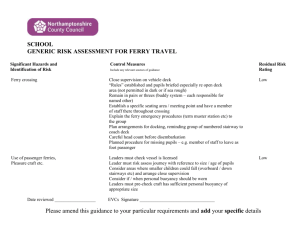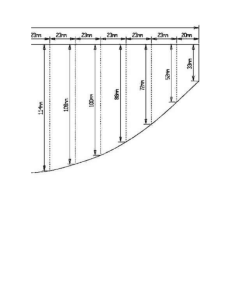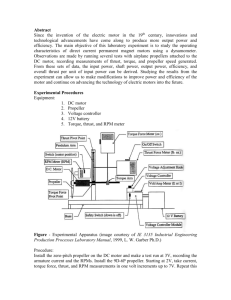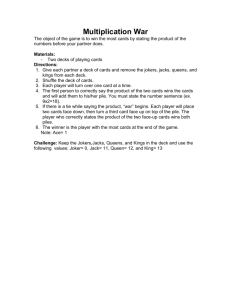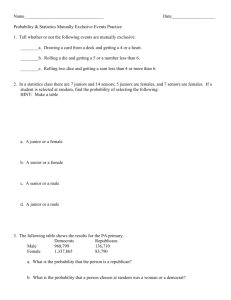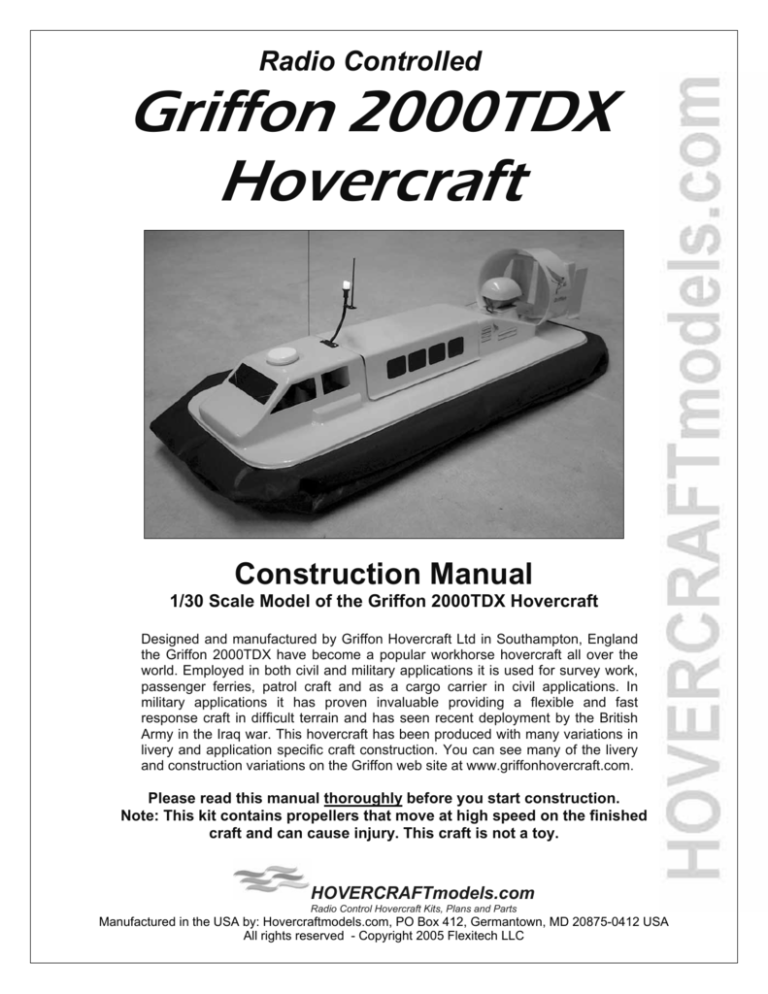
Radio Controlled
Griffon 2000TDX
Hovercraft
Construction Manual
1/30 Scale Model of the Griffon 2000TDX Hovercraft
Designed and manufactured by Griffon Hovercraft Ltd in Southampton, England
the Griffon 2000TDX have become a popular workhorse hovercraft all over the
world. Employed in both civil and military applications it is used for survey work,
passenger ferries, patrol craft and as a cargo carrier in civil applications. In
military applications it has proven invaluable providing a flexible and fast
response craft in difficult terrain and has seen recent deployment by the British
Army in the Iraq war. This hovercraft has been produced with many variations in
livery and application specific craft construction. You can see many of the livery
and construction variations on the Griffon web site at www.griffonhovercraft.com.
Please read this manual thoroughly before you start construction.
Note: This kit contains propellers that move at high speed on the finished
craft and can cause injury. This craft is not a toy.
HOVERCRAFTmodels.com
Radio Control Hovercraft Kits, Plans and Parts
Manufactured in the USA by: Hovercraftmodels.com, PO Box 412, Germantown, MD 20875-0412 USA
All rights reserved - Copyright 2005 Flexitech LLC
Griffon 2000TDX 1/30th Scale Radio Controlled Hovercraft
Hovercraftmodels.com
Acknowledgments
Hovercraftmodels.com gratefully acknowledges the assistance of Griffon Hovercraft Ltd. in
preparing the design of this model. The design of the Griffon 2000TD and 2000TDX craft and
related intellectual property as well as the Griffon logo are all copyright Griffon Hovercraft
Limited and are used by kind permission.
Griffon Hovercraft’s web site can be found at www.griffonhovercraft.com
_________________________________________________________
To complete the model you will require the following:
•
•
•
•
•
•
•
•
2, 3 or 4 channel radio control system (comprising transmitter, receiver, one standard size servo)
One electronic speed controller (Hovercraftmodels.com Part Number ESC 20 or ESC20R
recommended, see electrical section of this manual for more details).
4.8 to 8.4 volt (4 to 7 cell) 600-1000mAh NiCad, NiMh or LiPoly rechargeable battery pack
Battery charger for above battery pack.
Pack of stick-on ballast weights to balance the craft with the battery weight on board. (Available
at most hobby stores).
Hinge Tape – Used for electric model airplanes (found in most RC hobby stores, DuBro #319)
Servo Tape – For holding servos in place on small models ( most hobby stores that sell RC
airplanes will have this).
Glue – One tube of Polystyrene Cement, as used on plastic model kits. This will be used to glue
the parts of the kit together where required.
For construction:
Paint – Testors or Humbrol Paints can be used on this model, a 3oz spray can is enough to complete the
model.
Sealing - Tube of silicone bath seal.
Hobby Knife – Any small sharp hobby knife or box cutter knife.
Scissors – For cutting out plastic parts. Lexan or Canopy curved scissors are ideal.
Note: Some knowledge of building radio controlled models is helpful to complete this model.
Please seek help from someone who has experience in building model planes or boats if you have
any doubt about a step in this manual.
The mast and light illustrated on the cover of this manual is an optional addition to the model and not included in the kit
________________________________________________________________
Parts Preparation
Before construction starts you will need to prepare the parts for both painting and fitting together.
The first task is to cut all the pieces from the vacuum formed sheets. We recommend using small curved
scissors made for this job called canopy or Lexan scissors. Normal sharp scissors will do the job but
canopy scissors make cutting curved sections much easier.
Take your time when cutting the parts out to get a clean finish. The rudders and cabin especially require
some detailed attention. Take care on cutting the small parts and regularly check the fit to other related
parts to get the correct fit. It is possible to tear the plastic so take extra care and go slowly. Once you
have cut out the parts lightly sand the edges with fine sandpaper to remove any burrs or rough edges.
Painting
The craft should be painted after all the parts are cut out and some construction has been started. You
will cut out the cabin windows and assemble the thrust duct and rudder supports and fit the engine cowl
on the body before you paint the craft. The best painting results will be obtained by using spray cans of
model paint or an airbrush if you own one.
The rudder, elevators and rudder supports require painting on both sides. The upper deck requires
painting but it is not necessary to paint the lower deck as this is under the craft and cannot be seen.
2
Griffon 2000TDX 1/30th Scale Radio Controlled Hovercraft
Hovercraftmodels.com
Buoyancy Foam Preparation
The buoyancy foam ensures the craft floats with a good water clearance when the lift motor is turned off.
Supplied in your kit is a 13 ½ x 4 ½ inch slab of white foam. It must be cut to the correct size for the craft
comprising two sections. Measure and mark with a pencil on the foam two section, one 10 ½ inches in
size and the other 2 inches long. Cut these out using a hobby knife or hot wire cutter if you have one.
White foam cut to size
The two sections need to carved so they fit around
the lift duct. They only need to fit around a portion
of the duct leaving the sides free for airflow into
the skirt. Once these are cut set them aside for the
moment.
Upper Deck Initial Preparation
Cut out the deck from its surrounding molding. The deck should be cut so that it is flush with the 1/8th inch
step down at the edge of the deck. Once this is done you can sand the edge to a smooth finish if
required. Now you will cut the cabin windows out at the front of the deck.
Cabin with windows cut out
The windows have been marked in the plastic on both
sides of the cabin. These are opened up to act as lift air
‘cheat holes’. Using a 1/16th drill (a Dremel drill is ideal but
a handheld drill work just as well), drill a small hole in each
corner of the cabin windows. Now using a sharp modeling
knife score along the window lines between the holes.
Repeat this until the score line cuts through the plastic and
you can remove the center of the window. Do this for all 4
windows. Once they are cut out use fine sandpaper or a
small file to smooth any rough parts of the cut surface. If
you cut the window too far along the line you can simply
repair the cut with Polystyrene Cement and it will not show
one the deck is painted.
Lower Deck Initial Preparation
Cut the lower deck out from its surrounding mold. This time the deck is cut out on the inside of the 1/8th
inch step down so that the deck is flat at the edges.
Cut out and prepared lower deck.
Note the deck bolt holes cut out
To prepare the lower deck for
assembly the top of the lift duct
should be cut off to open up the
duct. This should be cut 1/16th inch
below the curved part at the top of
the duct. Only cut out the semi-circles either side of the bleed duct, not the entire hole. The air from the lift
propeller duct goes down into the skirt via the center bleed duct and inflates the skirt all around the craft
perimeter. The balance of the air continues down the semi-circular lift duct and provides air pressure
inside the plenum chamber made by the skirt for lift.
3
Griffon 2000TDX 1/30th Scale Radio Controlled Hovercraft
Hovercraftmodels.com
Upper and Lower Deck Bolt Holes
The major parts of this model are the upper and lower decks and these now need to be prepared for
painting and assembly. There are two holes marked by doughnut shapes in the top deck and three holes
marked in the same way on the lower deck. This is where 10-24 by 1 inch nylon deck bolts go to hold the
upper and lower decks of the craft together. Cut, drill or punch out these holes using a 3/16 drill or punch.
Upper deck with bolt holes cut out
Now set the deck bolt holes in the correct place in the buoyancy foam cut earlier. Place each of the two
slabs onto the lower deck in their correct positions. Using a 3/16th drill bit make a hole through the foam at
each deck bolt hole using the lower deck to align the drill. Once all three holes have been made remove
the buoyancy foam from the lower deck and move onto the next step.
Installing the Front Strut
The upper deck requires the addition of a fixing strut to be added to the cabin floor. A 10-24 bolt and nut
will secure the front of the upper deck to the lower deck. Using the supplied strip of white 0.04 thick
material cut a piece that is 1 ½ inch wide by 4 ¼ inches long. Mark the bolt hole location on this piece by
first finding and marking the center line along the 4 ½ inch length. Now measure in 5/16th inch along that
line from one side. Punch, drill or cut a 3/16th hole center on that point.
Strut installed
Now test fit the lower and upper decks to locate the strut
on the upper deck body. First pass one 10-24 by 1 inch
bolt through the center hole of the lower deck from the
underside (the side this will be on the ground when the
craft is operating) and then one bolt through the front
deck bolt hole. Now set the deck flat on the bench in front
of you with the bolts sticking up. Now pass the front and
rear foam buoyancy sections in place on the deck over
the bolts. Place the strut over the bolt end protruding from
the front section of foam. Secure lightly in place with a nut. Now place the upper deck over the center
bolt and set squarely over the strut at the front. With a pencil mark where the strut contacts the underside
of the upper deck. Once that is done disassemble the decks. The strut can now be glued in place on the
underside of the upper deck of the craft at the marked location using Polystyrene Cement.
Motor Cover
The motor cover dome is cut out to cover the thrust motor body. This molding is on the end of the lower
deck part. It should be cut off above the webbing on the part. Trim the molding so that it covers the wiring
end of the motor and just comes over the front of the motor body. It will be painted and then attached to
the motor using hook and loop at the final construction stage.
4
Griffon 2000TDX 1/30th Scale Radio Controlled Hovercraft
Hovercraftmodels.com
Engine Cover Preparation
Cut out the engine cover leaving a 1/8th inch lip around the outer edge of the part. The step down on the
part that faces the cabin should be cut so that it is 3/8th inch long. Again, smooth any rough edges with
fine sandpaper. A small doughnut mark on the back of the cover needs to be drilled out to 1/8th inch. This
is where the thrust motor wires will be run through later.
Engine cover cut out and prepared
The engine cover is now glued in place so that it rests
against the rear stop molded into the upper deck. Put a small
amount of glue around the lip of the part and then place it
onto the upper deck. Set the deck aside so that the glue can
set in about 20 minutes.
Engine cover attached
to the upper deck
Cutting out the thrust Duct
First the duct is cut from the cup shape molding. Measure 3/16th inch down from the closed end of the
duct. Mark a line all around the duct at this point and cut the closed
end off at this mark. Trim the open end to the point where it curves
outward.
Prepared thrust duct
The thrust duct is now cut open so that the lower edge is open and
shaped into a curve. This allows it to be glued to the duct support
on the upper deck later on. The curve guide is marked into the
plastic. Cut the part to that guide. You may have to trim the curve
further for propeller clearance when testing its fit onto the craft.
Cutting out the Rudders
The rudders are cut so that the tab is left at the base of the rudder and the rudder surface is flat. Holes
are drilled where the rudder horn goes and these are
indicated by small depressions in one of the rudders.
Rudders cut out and prepared.
Holes also need to be drilled in the bottom lip of the rudders
to accommodate the tie bars that join them. Measure in
1/8th inch in on the lip from the back of the rudder and drill a
1/16th inch hole at this point. Note that the center rudder
needs two holes, one on either side of the lip. The rudder
with the horn in only needs one on the outer edge. The left-hand side rudder only needs one on the inner
edge (see page 13 for more detail on the rudder tie bars).
5
Griffon 2000TDX 1/30th Scale Radio Controlled Hovercraft
Hovercraftmodels.com
Cutting out the Passenger Cabin Cover
This cover is cut so that fits between the engine cover and cabin on the
upper deck.
Cutting out the Rudder Support Structure
The rudder support structure is cut and then folded from the long strip molding. Cut out the entire strip
from its molding and fold down the two sides carefully away from the top bar.
Rudder support cut out and prepared
DO NOT score the fold lines with a knife blade as the plastic will
simply break apart. It will help to warm the fold lines slightly with a
hairdryer or model aircraft cover shrinking hot airgun first. Slowly
and carefully fold the sides down so that they are at 90º to the top
bar of the structure. Now fold the tabs at the bottom of the side
pieces inwards at 90º to complete the rudder support shaping.
Support top bar with side bent
down ready for assembly
Assembly of the Rudder Support
Now cut out the ‘T’ shaped base of the rudder support. The curved sides of the molding should be left in
place all around the piece to add strength except on the base and each end of the ‘T’. This needs to be
cut flat so it can be fitted onto the upper deck and glued to
the rest of the assembly. Drill a 1/16th inch hole where
marked by a small dimple in the piece.
The center rudder support must now be cut out. Remove
the molded edges so that it makes a flat part.
Start assembly by gluing the tabs at the base of the sides
of the support, under either side of the ‘T’ base. Use small
clamps to hold it in place while setting. Glue the center
support into the assembly using the groove in the base
and the line in the top of the rudder support as a guide for location. The rudder support is now complete.
6
Griffon 2000TDX 1/30th Scale Radio Controlled Hovercraft
Hovercraftmodels.com
Assembly and Installation the Rudder and Thrust Duct
Bend down
90 degrees
Bend down
90 degrees
Glue Duct Here
Rudder
Upper
Support
Rudder
Center
Support
Thrust Duct
Left Rudder
Support
Right Rudder
Support
Rudder
Base 'T'
Support
Rudder
Support and
Thrust Duct
Rear View
'T' Support
Retaining Screw
( Requires 5/64th
hex key)
Bend down
90 degrees
Bend down
90 degrees
Glue Tabs Here
Upper Deck
Rudder
Support
Assembly
Thrust Duct
Propeller
Thrust
Motor
Right
Hand
Rudder
Rudder
Base 'T'
Support
Motor Mount
Gray Clip
Thrust
Motor
Wires
Rudder
Support and
Thrust Duct
Side View
Engine
Cover
Rudder
Horn
'T' Support
Retaining Screw
(Option to glue here
where duct touches
engine cover)
Note: Drawing is not to scale
7
Upper Deck
Griffon 2000TDX 1/30th Scale Radio Controlled Hovercraft
Hovercraftmodels.com
Assembly of the Rudder Support and Thrust Duct.
The rudder support is attached to the thrust duct using two sloped tabs on either side of the top bar. Test
fit the thrust duct onto its upper deck supports so that the open curve is evenly spaced at the base of the
duct. Now put the rudder assembly into the rear of the duct and mark where the sloped tabs meet the
duct.
View of the competed rudder assembly
attached by the tabs glued to the thrust duct
Remove the duct and rudder support from the upper deck and glue the
rudder support in place where it was marked. Small clamps or
clothespins will be needed to keep the parts in place until they have set.
Once set it can then be fitted to the upper deck.
Attaching the Thrust Duct to the Upper Deck
Before assembly can begin, the thrust motor with its propeller has to be mounted on to the craft
temporarily to test for clearance. Slide one of the motors in the kit into a gray motor mount clip. Fit a
propeller to the motor by drilling its hub out to 5/64th (1.9mm). The propeller should be fitted so that the
molded writing on the propeller blade is facing the motor body. It will be a tight fit onto the motor shaft.
Push the propeller down on the shaft until there is 1/6th of the shaft still showing at the base where the
shaft meets the motor body. Now using some painters tape or sticky tape, mount the motor by locating
the motor clip base onto the thrust motor post. The propeller will be just inside the thrust duct when it is
mounted.
Thrust duct and rudder support
mounted onto the upper deck
Offer up the thrust duct into place at the rear of
the upper deck. The front of the duct should be
touching the outer corners of the engine cover
and its base should rest on the upper curved
deck support. The ‘T’ base of the rudder
assembly should be rested on the upright mount
molded into the rear of the upper deck. Using a
pencil mark through the hole on the ‘T’ base of
the rudder assembly so that a mark is left on the
upper deck upright mount. Now remove the duct
assembly and drill a 1/16th hole where the mark shows. Once this is done relocate the thrust duct and
using the supplied self-tapping #2 x 7/16 hex head screw, attach the ‘T’ base to the upper deck.
The base of the thrust duct should be temporarily taped to the thrust duct mount molded into the upper
deck. Now rotate the propeller as see that it does not touch the thrust duct at any point in its travel. If it
does, adjust the position of the duct and if necessary trim the curved parts at the bottom of the duct to
give the propeller free travel all around.
Once the thrust duct is located correctly, mark its position and glue the thrust duct lower edges to the
upper deck curved support. You may also add a small amount of glue to each lip where it touches the
engine cover to firmly fix the duct in place.
8
Griffon 2000TDX 1/30th Scale Radio Controlled Hovercraft
Hovercraftmodels.com
Fitting the Lift Motor Mount
The lift motor is located inside the front cabin on a beam glued between the cabin walls. A white 3 inch
long by 1 inch wide strip of plastic is supplied in your kit for this. The strip is located inline with the back
edge of the rear windows (towards the center of the craft). Cut and carefully fit the plastic strip so that it’s
a snug fit in this position. Locate the center of the strip you have cut and fix one of the self-adhesive gray
motor mount clips at this point so the open end of the clip faces downwards.
Take the remaining motor in the kit and drill and fit the propeller as you did for the thrust motor by drilling
the hole in the hub out to 5/64th inch and pushing the propeller onto the motor shaft. Be sure that the
propeller faces with the molded writing on it towards the motor body. Now push the motor into the gray
motor mount clip to check its fitting.
Cabin with lift motor mount fitted
Offer the whole assembly up into the cabin, locate
it correctly and temporarily hold it in place using
painters or sticky tape. Rotate the propeller and
see that it turns in the center of the widened area at
the base of the cabin. It should be evenly spaced
from the walls throughout its entire rotation. The
propeller must also sit so its front edge (the edge
towards the base of the cabin) does not protrude
below the cabin base.
Underside view with the motor with propeller fitted in
the motor mount and the lower deck fitted
You need to now test fit the lower deck and foam
buoyancy to test the correct lift duct clearance. Using
the 10-24 by 1 inch bolts located the lower deck,
buoyancy foam and into the upper deck check that the
lift motor propeller does not touch the top of the lower
deck lift duct. If it does, then trim a small amount from
the lift duct top to give the correct clearance. Once the duct clearance is correct carefully disassemble the
decks and mark the motor mount position. You can then glue the motor mount strip in place on the cabin
walls and put to deck aside to set. Don’t be tempted to remove the motor until the glue has fully set! Once
the glue is set remove the motor and the upper deck is ready to be painted.
The upper deck, duct, passenger cabin and rudders are now ready for painting.
Radar Cover/Hatch Cover
Supplied in your kit is a small two-part radar dome that also doubles as a
hatch cover if your finished craft is going to be a military type. Cut both
halves out from the molding and if assembling the radar cover trim one
shorter than the other so they nest one inside the other. They are they
glued in together and put aside to set.
Radar cover installed
If you’re using this as a hatch, then cut one half so that it has a 1/16th lip all
around it and glue it onto the center of the cabin on the upper deck.
9
Griffon 2000TDX 1/30th Scale Radio Controlled Hovercraft
Hovercraftmodels.com
The radar is painted separately from the rest of the parts and should be white and attached to the craft
cabin later when the craft is complete. If the parts are used as a hatch it is glued on immediately and
painted with the upper deck.
Wiring and Fitting the Lift Motor
Before we can finally assemble the craft the lift motor wires have to be soldered on. Cut the supplied
length of motor wire in half. One piece will be used for each motor. The wire tabs on the rear of the motor
are marked for polarity. The red wire goes to the tab next to the small round dot depressed in the motor
rear housing. The black wire goes to the other tab. Two capacitors supplied in your kit need to be fitted to
the motor to suppress noise, which will interfere with the radio system otherwise. The two capacitors
should be fitted to the motor as shown below:
Suppression
Capacitiors
4
10
10
4
Motor Case
Motor Terminals
Solder Both
Capacitors to
Motor Case
Capacitor Installation on the Motor
(Note: also fit these capacitors on the thrust motor)
The propeller is now fitted. First drill out the hub to 5/64th to accept the motor shaft. This will make the
propeller a tight fit on the 2mm motor shaft. Add a small amount of silicone seal around the inside of the
gray motor mount clip and then snap the motor into the clip in the craft cabin. The silicone seal will stop
the motor moving. The wire is routed out of the cabin via a small hole at the rear that enters the
passenger cabin area where the radio equipment and battery will be housed. The hole is marked on the
rear of the cabin by a small doughnut mark. Drill this hole out to 1/8th inch and pass the wires through it.
Once the wire is fitted seal the hole around the wire with a little silicone seal to stop water ingress.
Now final assembly of the craft can begin.
Final Assembly of the Griffon 2000TDX
Final construction starts with the lower deck and works upwards towards the upper deck.
Preparing the Skirt
The skirt is in the form of a bag and is ready made with bolt holes punched into it. First you will need to
turn the skirt inside out so the sealed edges are on the
inside.
Now a slit needs to be cut in the top side of the skirt to
allow the buoyancy foam to be inserted. Be sure to
only cut the top layer! With the lift duct end of the skirt
to your right (the craft bow end) cut a slit down the
center line of the skirt from the furthest bolt hole to the
lift duct opening. Again this should be done on the
top side of the skirt only!
Skirt top split
Lower Deck
Three 10-24 deck bolts are now inserted into the three
holes (in the center, under the engine cover area and in
front of the lift duct) from the bottom of the lower deck.
10
Griffon 2000TDX 1/30th Scale Radio Controlled Hovercraft
Hovercraftmodels.com
You may want to temporarily tape the heads of the bolts against the deck to hold them in place while
assembling the rest of hovercraft base. Now place the lower deck with the threaded shafts of the bolts
upward on the bench.
Before proceeding with the skirt assembly a 1/8th inch bead of silicone bath seal compound should be run
around the top side (opposite side from the deck bolt head) of the deck and the lift duct. This is important,
as it will seal the skirt against the deck and stop water ingress.
Silicone seal is put around the lower deck
Fitting the Skirt Assembly
Place the lower deck on the bench in front of
you with the lift duct to your left. Now pass the
lower layer of the skirt over the deck bolts and
lift duct so it rests on the lower deck and makes
contact with the silicone seal compound.
The hole around the duct is cut slightly smaller than the duct itself to get a tight fit so you may have to
stretch the skirt a little to make it fit. Next the buoyancy foam in inserted into the skirt through the opening
in the top layer of the skirt. Insert the front
section first and align the hole in the foam with
the bolt. Repeat this with the rear section of
foam. The skirt top layer can now be pulled
over the two bolts protruding from the topside
of the foam.
Skirt fitted with foam installed inside
Fitting the Upper Deck
The upper deck is now placed over the bolts protruding out of the top the
skirt. The front bolt protrudes through the strut and a nut is now placed
on it by reaching up through the lift duct. Put a 10-24 nut onto each of
the two other bolts. Be sure to get them tight enough to hold the deck in
place but do not over tighten them, as this will distort the deck. The craft
decks are now complete.
Front nut on top of the strut
Fitting the Rudder Servo
A hole must be cut in the motor housing left-hand side (viewed from the front of the craft). This allows the
servo shaft and arm to protrude through. A wide range of servos
can be used with this model. It was designed to take standard
servos such as Futaba 148, Hitec or an Airtronics. It can also be
used with any of the mini and micro servos if you want to make
the craft lighter.
Servo arm protruding from the engine cover
Note the ‘Z’ bend in the wire through the servo arm as shown
here:
11
Griffon 2000TDX 1/30th Scale Radio Controlled Hovercraft
Hovercraftmodels.com
It is worth running some silicone sealant around the servo case to ensure that any water that gets
between the superstructure and the upper deck does not get into the servo. The servo is mounted using
servo mounting tape or it can be glued in place.
Balance Weights: Stick on weights must be added to the craft to obtain a final balance if required. They
are used to counterbalance the craft against the weight of the battery and radio equipment in the front of
the craft. They may be located in the cabin roof, but before adding any weight try to shift the battery and
radio etc. to balance the craft.
Fitting the Passenger Cabin
The cabin is molded to be longer that the distance between the front cabin and the motor housing. You
must trim and fit the passenger cabin cover to be a snug fit between these two points. Carefully cut off the
excess a small piece at a time using a hobby knife or scissors until it fits. Once complete, carefully clean
up the edge using fine sandpaper. The cover should be held in place using the supplied hook and loop in
several locations to hold the cover firm under all operating conditions.
Thrust Motor Fitting
The thrust motor wires can now be soldered on just as with the lift motor and the propeller now fitted. First
drill out the hub to 5/64th to accept the motor shaft. This will make the propeller a tight fit on the 2mm
motor shaft. As with the lift motor fit the two supplied capacitors
using the same diagram shown with the lift motor instruction on
page10 for placing them. The gray clip is self-adhesive and is stuck
onto the thrust motor post at the rear of the engine housing. Be
sure it is level. The motor can now be fitted into the gray clip and as
with lift motor, first add a little silicone seal to the clip. Feed the
motor wires down through the hole in the engine housing back and
into the passenger cabin area.
Thrust motor installed and wired
Fitting the Rudders
The rudders are fitted using hinge tape, a tape commonly used with miniature RC electric aircraft. You
can also use strapping or other tape as long as it is waterproof. The rudder horn is located on the rudder
nearest the servo output arm. Small bumps have been molded into one of the rudders where this horn
fits. Drill 1/16 inch holes at these two locations. Secure the horn using two 0-80 x 5/16 nut and bolts
supplied in your kit. Once this is done the rudders can be fitted.
Two views of the rudder horn
in place on rudder
The rudders can now be fitted
on to the supports. The
flanges at the base of each
rudder go below the ‘T’ base
of the rudder support
assembly. Cut three 1 ¼ inch lengths of hinge tape and fit them to the center of each rudder starting with
the rudder nearest the servo (with the horn on). Fix the rudder to the upright support leaving a 1/2mm gap
between the two parts. Repeat this for the center and far side rudder. Test each rudder to make sure it
moves smoothly 20-25º either side of its center position.
12
Griffon 2000TDX 1/30th Scale Radio Controlled Hovercraft
Hovercraftmodels.com
Connecting the Servo to the Rudder
The length of the rod depends on the servo and servo arm that you use. To locate the push rod correctly
on your servo, first make a ‘Z’ bend in the servo end of the supplied 0.025inch steel wire. Connect this
through the white servo arm at the 2nd hole. Center the rudder and servo in its travel. Now mark on the
wire where the push rod crosses the 2nd hole on the rudder horn. Remove the push rod and bend a 'Z'
bend at that point in the arm and
connect up as shown in the photo.
Servo push rod fitted. The ‘Z’ bend is
used at both ends of the rod as shown
here:
When the servo moves the rudders
should freely swing 20-25º either side
of center for full throw of the
transmitter stick.
Installing the Rudder Tie Bars
The rudders are now joined together using tie bars made from 0.025inch steel wire. The ties are cut from
the steel rod supplied in your kit. Cut two, 2 inch sections of rod. Bend a ‘Z’ bend in one end of each rod.
Rudder tie bars installed
Line up the rudders so that they are parallel with
each other in the center position. Measure the
distance between the rudder tie bar holes in the lip of
the rudders.
Bend another ‘Z’ bend in the other end of the tie
bar at the point where it will cross the hole in the
opposite rudder lip. Fit the tie bars by flexing the
rudders slightly to accommodate the ‘Z’ bends.
Once fitted, cut off any excess wire after the ‘Z’
bend.
13
Griffon 2000TDX 1/30th Scale Radio Controlled Hovercraft
Hovercraftmodels.com
Radio, Speed Controller and Battery Fitted into the Craft
This model is set up for forward/reverse thrust using the ILCTM module
Final Preparation
Your Griffon 2000TDX construction is now complete! Check the craft over and be sure it’s ready to run.
You can now install the thrust motor cover and then apply the decals. The diagram of the real Griffon
2000TDX below gives general placement for the decals.
Griffon tail logo and name
Engine vents
NOTE - The propellers on this craft reach high speeds, NEVER put your hands
near the crafts propellers when it is powered on or is running. Always check for
those around you before running the craft and keep it well away from spectators
and animals.
14
Griffon 2000TDX 1/30th Scale Radio Controlled Hovercraft
Hovercraftmodels.com
When starting the Griffon 2000TD Model ALWAYS take these three easy safety
steps:
1 - Never fit or remove the battery when the model is power on
2 - Turn the transmitter on before powering the craft on
3 - Turn the craft power off before turning the transmitter off
Here is a simple checklist to run for the first and each subsequent run of your RC Hovercraft:
1. Check the clearance of the lift propeller in the duct. It should rotate freely and not touch any part of
the duct in its rotation.
2. Check the clearance of the thrust propeller in its duct. Adjust the motor position if required to get the
required clearance.
First Runs
On your first run briefly check the lift and thrust propellers are rotating in the right direction. The lift fan will
suck out air from the skirt if it’s incorrect so this is obvious! The thrust propeller is a little more subtle.
The thrust propeller will produce some thrust if it is rotated in either direction however a marked reduction
in forward thrust will be seen if it is fitted backwards. When fitted correctly the writing on the propeller
faces the motor body. To produce forward thrust the propeller will rotate in a counter clockwise direction
when viewed from the front of the craft looking towards the rudder.
Once you have this all working correctly, check the balance of the craft. Watch the craft as it rises to
hover. This is the pitch or front to back balance. When the balance is correct the front of the craft should
rise very slightly before the rear. You should also watch the lateral or side-to-side rise. The craft will tend
to rise on the left side (when viewed from the back of the craft) first. This is due to lift motor torque and the
weight of the servo on the right hand side. You may need to adjust the battery and radio position to get
the lateral and pitch balance correct. Take your time to get it right and the craft will run better.
When you are happy with the balance you are ready to start RC hovering. Get a feel for the craft, as it is
very different from a RC car or boat. On land it will always move with the camber of the land. On water the
waves and wind affect it. Note that the lift requirements vary with the surface the craft is running on.
Take your Griffon 2000TD onto a lake, boating pool or swimming pool when there is smooth water. Place
it on the water and start to increase the motor speed. The skirt will inflate and the lift air pressure will
increase. Very quickly it will reach the pressure boundary and you will see the craft suddenly rise off the
water. Now slowly add throttle as the craft moves away compensating for any wind drift with the rudders.
You will notice a bow wave in front of the skirt at first. As you apply full thrust and accelerate you will see
the craft rise over the bow wave and continue to accelerate without applying more power. This is the
hump speed and is the point at which the craft moves out of the depression it makes on the water when
hovering on water. It will now be hovering over the surface at full speed.
To slow down just decrease the motor speed and the skirt drag will pull you back below hump speed to a
standing stop very quickly.
There’s a lot of fun to be had on land or at your local lake. Take your time learn how all the controls
interact and you will be running rings round those RC boats in no time!
Have fun Hovering!
___________________________________________________________
15
Griffon 2000TDX 1/30th Scale Radio Controlled Hovercraft
Hovercraftmodels.com
Griffon 2000TDX RC Hovercraft Construction Manual
Copyright© 2005 Hovercraftmodels.com
Germantown, Maryland 20876
USA
All rights reserved
Printed and bound in the United States of America
No parts of this manual may be used or reproduced in any manner whatsoever without written
permission, except for brief quotations when used in reviews and critiques. You may contact us via email
via our web site at http://www.hovercraftmodels.com
Hovercraftmodels.com gratefully acknowledges the assistance of Griffon Hovercraft Ltd. in preparing this
design of this model. The design of the Griffon 2000TD and 2000TDX craft and related intellectual
property as well as the Griffon logo are all copyright Griffon Hovercraft Limited and used by kind
permission. Griffon’s web site can be found at www.griffonhovercraft.com
2003/2004
Hovercraftmodels.com
PO Box 412
Germantown, MD 20875-0412
USA
Phone: +1 (301) 947 1526
Web Site: http://hovercraftmodels.com
For Your Notes:
16
HOVERCRAFTmodels.com
Want to learn more about RC Hovercraft?
Here is the book with everything you want to know
Introduction to
Radio Control
Hovercraft
by Kevin Jackson and Mark Porter
For the first time, this comprehensive
tutorial brings together all the information
required to design and build a successful
radio controlled Hovercraft model.
Includes:
• Hovercraft principles
• Building for scale and sport
• Construction materials and techniques
• Lift fan design
• Selecting motors
• Electrical setup
• Skirt design
• Selecting radios
• Craft operation
Written by two leading authorities in RC
Hovercraft design, Kevin Jackson and
Mark Porter take you through both the
theoretical and practical aspects of the
design and construction process.
Generously illustrated with photos, 3D cutaways and diagrams, the principles are explained in theory and shown at
work on real models. Setup and operation of the finished model are discussed along with some of the unique
challenges of controlling the craft.
The book offers the experienced or first time modeler an opportunity to get started in the rapidly growing part of the
RC hobby. Part plane and part boat, this unusual craft offers a whole new experience and this book is an ideal
companion when venturing into this new field of radio control models.
Price $22.95 (Shipping within the USA $6.95 – To Europe and the UK $8.50)
Published by Flexitech LLC, 124 pages, perfect bound, ISBN 0-9753414-1-3
For More information contact: Flexitech LLC, PO Box 412, Germantown, MD 20876, USA
Phone +1 (301) 947 1526 Email: books@hovercraftmodels.com
Visit our web site and buy this book online at: www.hovercraftmodels.com
Also available online at:

